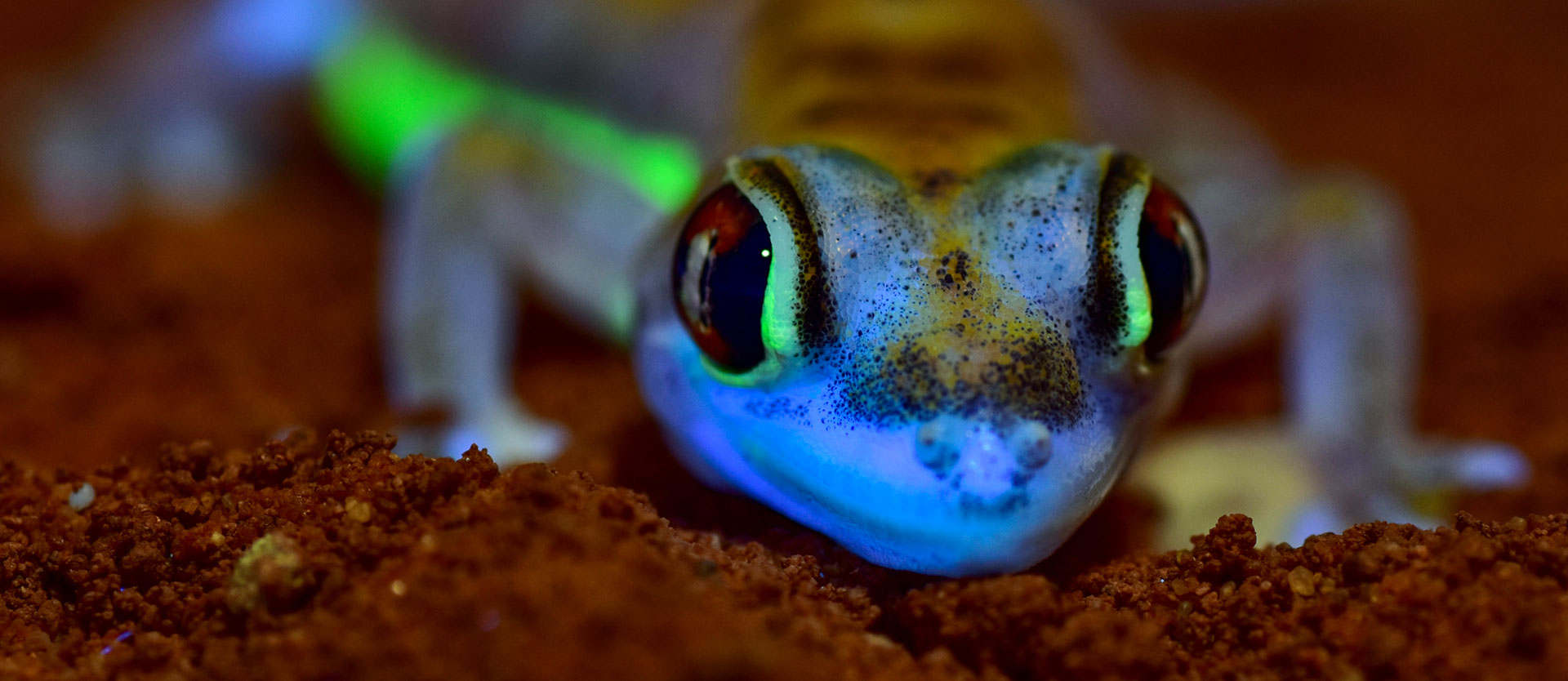
A Green Glow in the Moonlit Desert

The web-footed gecko Pachydactylus rangei, which is found in the deserts of Namibia, emits a neon-green fluorescence on exposure to UV light. Notably, this fluorescence is confined to sharply defined stripes on its flanks and around its eyes, as researchers at LMU Munich and Munich’s University of Applied Sciences recently reported. From the lizard’s perspective, these markings are quite obvious, which suggests that they serve as recognition signals for members of the local population. Further study showed that the fluorescence originates from pigmented skin cells that contain guanine crystals. This is the first time that such guanine-based and astonishingly intense fluorescence has been detected in land mammals.

Munich-based zoologists have discovered an unusual form of biofluorescence in the African web-footed gecko Pachydactylus rangei.
The ability of many organisms, both unicellular and multicellular, to autonomously emit light is an intriguing feature of the biosphere. Some of the most striking and widely known examples are found in fish that live in the lower depths of the oceans. These species absorb certain wavelengths of the sparse light that reaches them and re-emit it a longer wavelength as biofluorescence, which can be perceived by other denizens of the deep, and therefore serves as a means of communication. Only in recent years has it become apparent that several terrestrial vertebrates (tetrapods) also make use of the phenomenon. Some reptiles and amphibians exploit the intrinsic fluorescence of bone, while others make use of fluorescent molecules that are found in the lymphatic vessels beneath the skin.
“In the case of the web-footed gecko, the fluorescence mechanism must be a novel one. The pattern of neon-green fluorescence is clearly associated with the skin,” says Dr. David Prötzel, lead author of the new study. Its discovery was serendipitous. For the last 10 years, Prötzel has reared and studied geckos in the Bavarian State Collection for Zoology (SNSB) in Munich, and one day he had the happy idea of exposing them to the rays of a UV lamp. To his surprise and delight, Pachydactylus rangei showed characteristically localised patterns of fluorescence. He and his colleagues went on to show that the fluorescence is specifically associated with specialised pigment cells called iridophores in the reptile‘s skin. Non-fluorescent iridophores containing guanine crystals that reflect light make a significant contribution to the pigmentation of the skin in geckos and other lizards. However, P. rangei is the first terrestrial vertebrate which has been shown to possess iridophores that also fluoresce. “The intensity of its fluorescence is significantly higher than the bone-based fluorescence that we discovered in chameleons three years ago. Indeed, it is one of the brightest fluorescence phenomena so far observed in terrestrial vertebrates,” says Dr. Frank Glaw, Curator of Reptiles and Amphibians at the SNSB.
Web-footed geckos are active mainly at night. During the day, their tawny-brown skin colour provides perfect camouflage against the background of the desert sand. On their nocturnal treks, the only significant source of light available is the Moon. The blue component of moonlight excites a (so far unidentified) fluorophore present in the cells that make up the fluorescent regions of the skin, and the absorbed energy is re-emitted as a brighter, neon-green shade of light. To a human observer, the animal‘s flanks appear to have been highlighted with a marker pen, and the signal effect of the stripes is unmistakable.
Why so many animal species fluoresce when irradiated with ultraviolet or blue light remains unclear. In some cases of fluorescence in vertebrates, the effect may well be incidental and probably has no biological function. “In the case of the web-footed gecko however, the intensity and the organisation of the fluorescent regions around the eyes and along the flanks suggests that the phenomenon serves as a signal for conspecifics, which can perhaps be seen over longer distances,” says Dr. Mark D. Scherz, an evolutionary biologist at Potsdam University and co-author of the new report.
Original publication:
Prötzel, D., Heß, M., Schwager, M., Glaw, F. & Scherz, M.D. (2021).
Neon-green fluorescence in the desert gecko Pachydactylus rangei caused by iridophores.
Sci. Rep. 11, 297 www.nature.com/articles/s41598-020-79706-z












